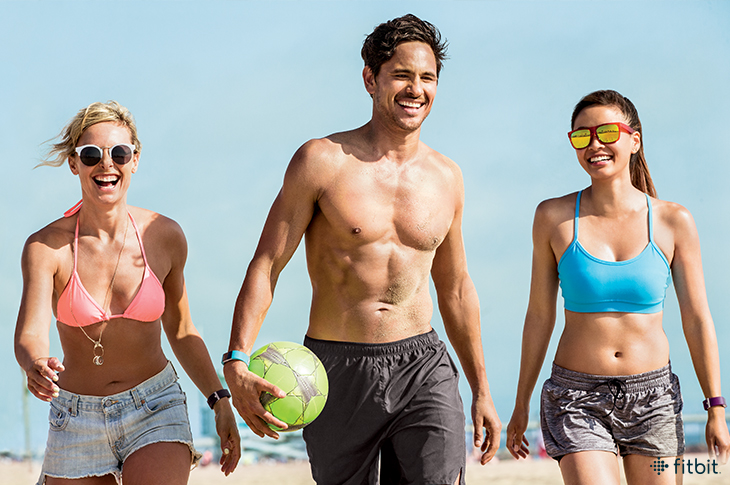 One in five Americans will develop skin cancer in their lifetime, according to the Skin Cancer Foundation. It’s a sobering statistic, but it doesn’t mean you can’t rack up your steps outside. Wearing sunscreen can help protect against the harmful effects of the sun and slash your risk.
One in five Americans will develop skin cancer in their lifetime, according to the Skin Cancer Foundation. It’s a sobering statistic, but it doesn’t mean you can’t rack up your steps outside. Wearing sunscreen can help protect against the harmful effects of the sun and slash your risk.
The Sun and Your Skin
A quick science lesson: Sunlight is made up of a spectrum of light waves. Some of those waves are harmless, but others can hurt. Ultraviolet B (UVB) radiation can burn the surface of your skin, and ultraviolet A (UVA) can go deep, causing cellular damage that can lead to skin cancer
Any amount of sun exposure can be dangerous—86 percent of melanoma and 90 percent of non-melanoma skin cancers have been linked to ultraviolet radiation. And because damage is cumulative, the more sun exposure you get during your life, the higher your chances of developing cancer.
That’s why it’s important to stay covered whenever you’re outside. “I like to tell my patients, ‘If it’s daylight, UV rays are hitting you,’’ says Brooke A. Jackson, MD, board-certified dermatologist and director of Skin Wellness Dermatology Associates in Durham, NC. Clouds and shade do offer some protection, but 40 percent of the sun’s ultraviolet radiation can still reach the earth on an overcast day. If it’s light enough outside for you to see, the sun can see you, too.
What’s the Best Sunscreen?
Wide hats and dark clothing create the best defense, by far. But long-sleeve shirts and pants in the heat isn’t very realistic. Wearing sunscreen is the next best thing.
Sunscreen comes in lots of forms (lotions, sprays, sticks, etc.) and touts all kinds of benefits (waterproof, anti-aging, and more!). Look for one that offers broad-spectrum protection—meaning, it can guard your skin from both UVA and UVB rays. And go for a sun protection factor (SPF) of at least 15. (SPF is a measure of how much UVB radiation a product can block—SPF 15 can shield you from about 93 percent, SPF 30 about 97 percent, and SPF 50 about 98 percent. There is no rating for UVA protection.) Beyond that, they can all get the job done.
No, really, what’s the best sunscreen? “The one you will actually use and remember to reapply,” says Jackson. To get maximum results from your sunscreen, you need to apply 1 oz. every two hours to all exposed body parts, ideally 15 to 20 minutes before heading outdoors, says Jackson. And if you’re using a spray, be sure to rub it in. “Think of it as connecting the dots, says Jackson. “Sprays produce droplets—they need to be connected with a good rub to give you complete coverage.”
Do You Really Need to Reapply Sunscreen?
Yes. Slathering the stuff on every two hours might seem like chore—not to mention a ploy to make that bottle empty faster, but it really is something you should do. Every. Two. Hours.
“Sunscreens with chemical ingredients, like avobenzone and benzophenone, work by absorbing UV rays—and they weaken with time,” says Jackson. “Physical ingredients, like titanium dioxide and zinc oxide, sit on top of your skin and deflect radiation, but they can be comprised by swimming and toweling off.” No matter which kind of sunscreen you use, reapplying is a must.
Sunscreen and Your Fitbit Tracker
Some ingredients found in sunscreens, lotions, and other cosmetics may cause elastomer and nylon to become discolored or deteriorate with repeated contact. If you wear a wrist-based Fitbit tracker, it’s a good idea to remove it before you apply your sunscreen, and allow it to completely absorb before strapping your tracker back on. It only takes a couple of minutes to lather up and wait for sunscreen to sink in, so don’t worry about missing out on steps.
At the end of a sunny day—undoubtedly filled with stepping, sweating, and reapplying sunscreen, you can remove any build-up on your nylon or elastomer band by washing it with a soap-free cleanser, like Cetaphil Gentle Skin Cleanser or Aquanil; rinse thoroughly, and dry well.
This information is for educational purposes only and is not intended as a substitute for medical diagnosis or treatment. You should not use this information to diagnose or treat a health problem or condition. Always check with your doctor before changing your diet, altering your sleep habits, taking supplements, or starting a new fitness routine.

Love seeing this from Fitbit. We are always looking for sun care education efforts and this one hit’s all the marks. One thing that is key, as the article says make sure to use a broad spectrum (check the label for the phrase) sunscreen. It’s the only way to make sure you are getting UVB and UVA protection yet many are unaware to look for it.